Unveiling Climate-Adaptive World Heritage Management Strategies: The Netherlands as a Case Study
Abstract
1. Introduction
2. Materials and Methods
2.1. Data Collection
- WH properties on the List of World Heritage in Danger;
- WH properties that require conservation reports or monitoring tasks requested by the World Heritage Committee in previous sessions;
- WH properties under threat since the previous World Heritage Committee session and requiring immediate actions beyond consultations;
- WH properties for which the World Heritage Committee requested follow-up after being inscribed on the World Heritage List.
2.2. Data Preparation and Processing
2.3. Visualisation
3. Results
3.1. Hierarchical Codes for SOUVs, MPs and SoC Reports by State Parties
3.1.1. Codes Developed from the SOUV Dataset
3.1.2. Codes Developed from the MPs and SoC Reports by the State Parties
3.2. WH Properties and Their Relevance to Climate Adaptation in SOUV Dataset
3.3. Climate-Adaptive WH Management Strategies in MPs
3.4. Climate-Adaptive WH Management Strategies in SoC Reports by State Parties
4. Discussion
4.1. The Documents and Their Relevance to Climate Adaptation
4.2. Conservation for Climate-Robust Living Environments
4.3. Heritage as a Collaborative Knowledge Hub
4.4. Inconsistency in Heritage-Inclusive Sustainable Development and Environmental Management
4.5. Limitations and Recommendations
5. Conclusions
Author Contributions
Funding
Institutional Review Board Statement
Informed Consent Statement
Data Availability Statement
Conflicts of Interest
Abbreviations
| CAWHMS | Climate-Adaptive World Heritage Management Strategy |
| GHG | Greenhouse gas |
| HUL | Historic Urban Landscape |
| KIN | Dutch Climate Research Initiative (Klimaatonderzoek Initiatief Nederland) |
| MP | Management plan |
| NAS | National Climate Adaptation Strategy |
| NGO | Non-governmental organisation |
| OUV | Outstanding Universal Value |
| SOUV | Statement of Outstanding Universal Value |
| SoC | State of Conservation |
| TWSC | Trilateral Wadden Sea Cooperation |
| WH | World Heritage |
Appendix A
| WH Property | Document Link |
|---|---|
| Schokland and Surroundings | https://whc.unesco.org/en/list/739 (accessed on 27 March 2025) |
| Dutch Water Defence Lines | https://whc.unesco.org/en/list/759 (accessed on 27 March 2025) |
| Mill Network at Kinderdijk-Elshout | https://whc.unesco.org/en/list/818 (accessed on 27 March 2025) |
| D.F. Wouda Steam Pumping Station | https://whc.unesco.org/en/list/867 (accessed on 27 March 2025) |
| Beemster Polder | https://whc.unesco.org/en/list/899 (accessed on 27 March 2025) |
| Rietveld Schröder House | https://whc.unesco.org/en/list/965 (accessed on 27 March 2025) |
| Wadden Sea | https://whc.unesco.org/en/list/1314 (accessed on 27 March 2025) |
| Seventeenth-Century Canal Ring Area of Amsterdam inside the Singelgracht | https://whc.unesco.org/en/list/1349 (accessed on 27 March 2025) |
| Van Nellefabriek | https://whc.unesco.org/en/list/1441 (accessed on 27 March 2025) |
| Colonies of Benevolence | https://whc.unesco.org/en/list/1555 (accessed on 27 March 2025) |
| Frontiers of the Roman Empire—The Lower German Limes | https://whc.unesco.org/en/list/1631 (accessed on 27 March 2025) |
| Eisinga Planetarium in Franeker | https://whc.unesco.org/en/list/1683 (accessed on 27 March 2025) |
Appendix B
| WH Property | Document Link | Page Numbers Relevant to Keywords in Table 1 |
|---|---|---|
| Schokland and Surroundings | https://whc.unesco.org/document/207277 (accessed on 27 March 2025) | pp. 5–35 |
| Dutch Water Defence Lines | https://whc.unesco.org/document/177896 (accessed on 27 March 2025) | p. 49; pp. 102–104; pp. 163–170 |
| Mill Network at Kinderdijk-Elshout | https://whc.unesco.org/document/193466 (accessed on 27 March 2025) | pp. 14–24; pp. 29–30 |
| Beemster Polder | https://whc.unesco.org/document/218353 (accessed on 27 March 2025) | p. 11; pp. 17–22; pp. 28–33; pp. 37–38 |
| Rietveld Schröder House | https://whc.unesco.org/document/219693 (accessed on 27 March 2025) | pp. 10–13; pp. 19–22 |
| Wadden Sea | https://whc.unesco.org/document/208611 (accessed on 27 March 2025) | pp. 11–13; p. 15; pp. 17–37 |
| Seventeenth-Century Canal Ring Area of Amsterdam inside the Singelgracht | https://whc.unesco.org/document/206323 (accessed on 27 March 2025) | pp. 8–12; p. 20; pp. 38–39; pp. 57–65; pp. 76–77 |
| Van Nellefabriek | https://whc.unesco.org/document/187731 (accessed on 27 March 2025) | pp. 8–14; p. 18 |
| Colonies of Benevolence | https://whc.unesco.org/document/180470 (accessed on 27 March 2025) | pp. 57–62; pp. 73–75; pp. 118–126; pp. 189–190; pp. 227–228; p. 269 |
| Frontiers of the Roman Empire—The Lower German Limes | https://whc.unesco.org/document/184624 (accessed on 27 March 2025) | pp. 17–43; pp. 47–49 |
| Eisinga Planetarium in Franeker | https://whc.unesco.org/document/195151 (accessed on 27 March 2025) | pp. 25–31; pp. 52–66; pp. 72–74; pp. 77–85; pp. 90–94; pp. 111–112; pp. 140–143 |
Appendix C
| WH Property | Document Link | Page Numbers Relevant to Keywords in Table 1 |
|---|---|---|
| Dutch Water Defence Lines | https://whc.unesco.org/document/218129 (accessed on 27 March 2025) | pp. 1–11 |
| Wadden Sea | https://whc.unesco.org/document/205413 (accessed on 27 March 2025) | pp. 6–44 |
References
- World Meteorological Organization. State of the Global Climate 2024; World Meteorological Organization: Geneva, Switzerland, 2025; ISBN 978-92-63-11368-5. [Google Scholar]
- Cave, C.; Negussie, E. World Heritage Conservation: The World Heritage Convention, Linking Culture and Nature for Sustainable Development, 1st ed.; Routledge: London, UK, 2017. [Google Scholar] [CrossRef]
- Seekamp, E.; Jo, E. Resilience and Transformation of Heritage Sites to Accommodate for Loss and Learning in a Changing Climate. Clim. Change 2020, 162, 41–55. [Google Scholar] [CrossRef]
- De Mulder, E.F.J. Water. In The Netherlands and the Dutch: A Physical and Human Geography, 1st ed.; De Pater, B.C., Droogleever Fortuijn, J.C., De Klerk, L.A., Van Dijk, J., Eds.; Springer International Publishing AG: Cham, Switzerland, 2019; pp. 7–34. [Google Scholar] [CrossRef]
- Droogmakerij de Beemster (Beemster Polder). Available online: https://whc.unesco.org/en/list/899 (accessed on 27 March 2025).
- Schokland and Surroundings. Available online: https://whc.unesco.org/en/list/739 (accessed on 27 March 2025).
- Fatorić, S.; Egberts, L. Realising the Potential of Cultural Heritage to Achieve Climate Change Actions in The Netherlands. J. Environ. Manag. 2020, 274, 111107. [Google Scholar] [CrossRef] [PubMed]
- Netherlands Climate Resilience Policy Indicator. Available online: https://www.iea.org/articles/netherlands-climate-resilience-policy-indicator (accessed on 27 March 2025).
- Brakkee, E.; van Huijgevoort, M.H.J.; Bartholomeus, R.P. Improved Understanding of Regional Groundwater Drought Development Through Time Series Modelling: The 2018–2019 Drought in The Netherlands. Hydrol. Earth Syst. Sci. 2022, 26, 551–569. [Google Scholar] [CrossRef]
- 2025 Delta Programme Towards a New Balance in the Living Environment: Room to Live with Water. Available online: https://english.deltaprogramma.nl/binaries/delta-commissioner/documenten/publications/2024/09/17/dp2025-complete-version/252.105_Deltaprogramma+2025+EN.pdf (accessed on 27 March 2025).
- Make-Atons Voor de Nieuwe Nationale Klimaatadaptiestrategie. Available online: https://hetkin.nl/makeatons-2024/ (accessed on 11 April 2025).
- De Tweede Ronde Make-Atons Is van Start! Available online: https://hetkin.nl/de-tweede-ronde-make-atons-is-van-start/ (accessed on 11 April 2025).
- Lucchi, E.; Turati, F.; Colombo, B.; Schito, E. Climate-Responsive Design Practices: A Transdisciplinary Methodology for Achieving Sustainable Development Goals in Cultural and Natural Heritage. J. Clean. Prod. 2024, 457, 142431. [Google Scholar] [CrossRef]
- Policy for the Integration of a Sustainable Development Perspective into the Processes of the World Heritage Convention. Available online: https://whc.unesco.org/document/139146 (accessed on 11 April 2025).
- Fatorić, S.; Daly, C. Towards a climate-smart cultural heritage management. Wiley Interdiscip. Rev. Clim. Change 2023, 14, e855. [Google Scholar] [CrossRef]
- Outstanding Universal Value. Available online: https://whc.unesco.org/en/glossary/327 (accessed on 27 March 2025).
- Samuels, K.L.; Platts, E.J. Global Climate Change and UNESCO World Heritage. Int. J. Cult. Prop. 2022, 29, 409–432. [Google Scholar] [CrossRef]
- UNESCO World Heritage Convention Netherlands (Kingdom of the). Available online: https://whc.unesco.org/en/statesparties/n (accessed on 12 April 2025).
- Statement of OUV. Available online: https://whc.unesco.org/en/glossary/369 (accessed on 28 March 2025).
- UNESCO; ICCROM; ICOMOS; IUCN. Preparing World Heritage Nominations, 2nd ed.; United Nations Educational, Scientific and Cultural Organization World Heritage Centre: Paris, France, 2011; pp. 1–135. ISBN 978-92-3-001029-4. [Google Scholar]
- State of Conservation Report. Available online: https://whc.unesco.org/en/glossary/367 (accessed on 28 March 2025).
- Reactive Monitoring Process. Available online: https://whc.unesco.org/en/reactive-monitoring/ (accessed on 12 April 2025).
- Periodic Reporting. Available online: https://whc.unesco.org/en/periodicreporting/ (accessed on 27 April 2025).
- Aan de Slag Met Update Managementplan UNESCO Werelderfgoed ir. D.F. Woudagemaal. Available online: https://land-id.nl/aan-de-slag-met-update-managementplan-unesco-werelderfgoed-ir-d-f-woudagemaal/ (accessed on 28 March 2025).
- Chandra, Y.; Shang, L. Inductive Coding. In Qualitative Research Using R: A Systematic Approach, 1st ed.; Chandar, Y., Shang, L., Eds.; Springer Nature Singapore: Singapore, 2019; pp. 107–117. [Google Scholar] [CrossRef]
- Morse, J.M.; Bowers, B.J.; Charmaz, K.; Clarke, A.E.; Corbin, J.; Porr, C.J. The Maturation of Grounded Theory. In Developing Grounded Theory, 2nd ed.; Morse, J.M., Bowers, B.J., Charmaz, K., Clarke, A.E., Corbin, J., Porr, C.J., Stern, P.N., Eds.; Routledge: New York, NY, USA; London, UK, 2021; pp. 3–22. [Google Scholar] [CrossRef]
- Sloggett, R.; Scott, M. Introduction. In Climatic and Environmental Threats to Cultural Heritage, 1st ed.; Sloggett, R., Scott, M., Eds.; Routledge: New York, NY, USA; London, UK, 2023; pp. 1–9. [Google Scholar] [CrossRef]
- Scott, M.; Sloggett, R. Changed Responses to the Changing Threat of Climate-induced Fire and Drought. In Climatic and Environmental Threats to Cultural Heritage, 1st ed.; Sloggett, R., Scott, M., Eds.; Routledge: New York, NY, USA; London, UK, 2023; pp. 99–117. [Google Scholar] [CrossRef]
- Policy Document on Climate Action for World Heritage (11/2023). Available online: https://whc.unesco.org/en/documents/204421 (accessed on 4 April 2025).
- Porter, W.P.; Murphy, C.P.; Williams, D.R.; O’Handley, B.J.; Wang, C. Hierarchical Sankey Diagram: Design and Evaluation. In Advances in Visual Computing, 1st ed.; Bebis, G., Athitsos, V., Yan, T., Lau, M., Li, F., Shi, C., Yuan, X., Mousas, C., Bruder, G., Eds.; Springer Nature Switzerland AG: Cham, Switzerland, 2021; pp. 386–397. [Google Scholar] [CrossRef]
- Bastian, M.; Heymann, S.; Jacomy, M. An Open Source Software for Exploring and Manipulating Networks. Proc. Int. AAAI Conf. Web Soc. Media 2009, 3, 361–362. [Google Scholar] [CrossRef]
- Khokhar, D. Using Graph Layout Algorithms. In Gephi Cookbook: Over 90 Hands-on Recipes to Master the Art of Network Analysis and Visualization with Gephi, 1st ed.; Nair, A., Ed.; Packt Publishing: Birmingham, UK, 2015; pp. 47–86. ISBN 9781783987405. [Google Scholar]
- Biodiversity. Available online: https://whc.unesco.org/en/glossary/193 (accessed on 31 March 2025).
- Ecosystem Services. Available online: https://whc.unesco.org/en/glossary/234 (accessed on 31 March 2025).
- Features. Available online: https://whc.unesco.org/en/glossary/244 (accessed on 31 March 2025).
- Seventeenth-Century Canal Ring Area of Amsterdam Inside the Singelgracht. Available online: https://whc.unesco.org/en/list/1349 (accessed on 19 April 2025).
- Mill Network at Kinderdijk-Elshout. Available online: https://whc.unesco.org/en/list/818 (accessed on 27 March 2025).
- Ir.D.F. Woudagemaal (D.F. Wouda Steam Pumping Station). Available online: https://whc.unesco.org/en/list/867 (accessed on 28 March 2025).
- Integrity. Available online: https://whc.unesco.org/en/glossary/280 (accessed on 31 March 2025).
- Wadden Sea. Available online: https://whc.unesco.org/en/list/1314 (accessed on 28 March 2025).
- Frontiers of the Roman Empire—The Lower German Limes. Available online: https://whc.unesco.org/en/list/1631 (accessed on 19 April 2025).
- The SIMP Integrated Management Plan for ONE Wadden Sea World Heritage. Available online: https://whc.unesco.org/document/208611 (accessed on 19 April 2025).
- Management Plan UNESCO World Heritage Site The Seventeenth-Century Canal Ring Area of Amsterdam Inside the Singelgracht. Available online: https://whc.unesco.org/document/206323 (accessed on 27 March 2025).
- Management Plan of the World Heritage Property ‘Droogmakerij de Beemster (Beemster Polder)’ 2022–2027. Available online: https://whc.unesco.org/document/218353 (accessed on 28 March 2025).
- Management Plan Colonies of Benevolence. Available online: https://whc.unesco.org/document/180470 (accessed on 28 March 2025).
- Dutch Water Defence Lines Management Plan 2018–2020. Available online: https://whc.unesco.org/document/177896 (accessed on 19 April 2025).
- Management Plan World Heritage Schokland and Surroundings 2020–2025. Available online: https://whc.unesco.org/document/207277 (accessed on 19 April 2025).
- Management Plan Rietveld Schröder House. Available online: https://whc.unesco.org/document/219693 (accessed on 19 April 2025).
- Insight—Overview—Outlook Update Management World Heritage Kinderdijk-Elshout. Available online: https://whc.unesco.org/document/193466 (accessed on 28 March 2025).
- Management Plan Update Van Nellefabriek 2021–2026. Available online: https://whc.unesco.org/document/187731 (accessed on 19 April 2025).
- Moving Heaven and Earth the Royal Eise Eisinga Planetarium World Heritage Management Plan. Available online: https://whc.unesco.org/document/195151 (accessed on 26 April 2025).
- State of Conservation Report by the State Party/Rapport de l’Etat Partie sur L’état de Conservation. Available online: https://whc.unesco.org/document/218129 (accessed on 8 April 2025).
- Common Wadden Sea Secretariat. Report on the State of Conservation of the World Heritage Property “The Wadden Sea (N1314)”; Common Wadden Sea Secretariat: Wilhelmshaven, Germany, 2024; Available online: https://whc.unesco.org/document/205413 (accessed on 8 April 2025).
- Kabat, P.; Bazelmans, J.; van Dijk, J.; Herman, P.M.J.; van Oijen, T.; Pejrup, M.; Reise, K.; Speelman, H.; Wolff, W.J. The Wadden Sea Region: Towards a Science for Sustainable Development. Ocean Coast. Manag. 2012, 68, 4–17. [Google Scholar] [CrossRef]
- Lin, B.B.; Melbourne-Thomas, J.; Hopkins, M.; Dunlop, M.; Macgregor, N.A.; Merson, S.D.; Vertigan, C.; Hill, R. Holistic climate change adaptation for World Heritage. Nat. Sustain. 2023, 6, 1157–1165. [Google Scholar] [CrossRef]
- Thuc, L.D.; Van Nguyen, M.; Duy, K.H.; Nguyen Van, D. Prioritizing Barriers to the Conservation of Cultural Heritage Buildings in Adaptation to Urbanization and Climate Change. J. Clean. Prod. 2024, 473, 143529. [Google Scholar] [CrossRef]
- UNESCO Recommendation on the Historic Urban Landscape. Available online: https://whc.unesco.org/en/hul/ (accessed on 27 April 2025).
- De Groeve, M.; Kale, E.; Godts, S.; Orr, S.A.; De Kock, T. Impact of Vertical Greening on Urban Microclimate and Historic Building Materials: A Meta-analysis. Build. Environ. 2024, 253, 111365. [Google Scholar] [CrossRef]
- Apostolaki, S. Nature-Based Solutions for Sustainable Stormwater Management as Means to Increase Resilience to Climate Change, Promote Circularity and Improve City Aesthetics. In Nature-Based Solutions for Circular Management of Urban Water Stefanakis, 1st ed.; Stefanakis, A., Oral, H.V., Calheiros, C., Carvalho, P., Eds.; Springer: Cham, Switzerland, 2024; pp. 315–331. [Google Scholar] [CrossRef]
- Egberts, L. A Future for Cultural History of the Dutch Wadden Region. Challenges and Policies in a Maritime-agricultural Landscape. In Waddenland Oustanding, 1st ed.; Schroor, M., Egberts, L., Eds.; Amsterdam University Press: Amsterdam, The Netherlands, 2018; pp. 315–328. [Google Scholar] [CrossRef]
- Perry, J. Climate Change Adaptation in Natural World Heritage Sites: A Triage Approach. Climate 2019, 7, 105. [Google Scholar] [CrossRef]
- Environment and Planning Act of The Netherlands. Available online: https://iplo.nl/regelgeving/omgevingswet/english-environment-and-planning-act/ (accessed on 27 April 2025).
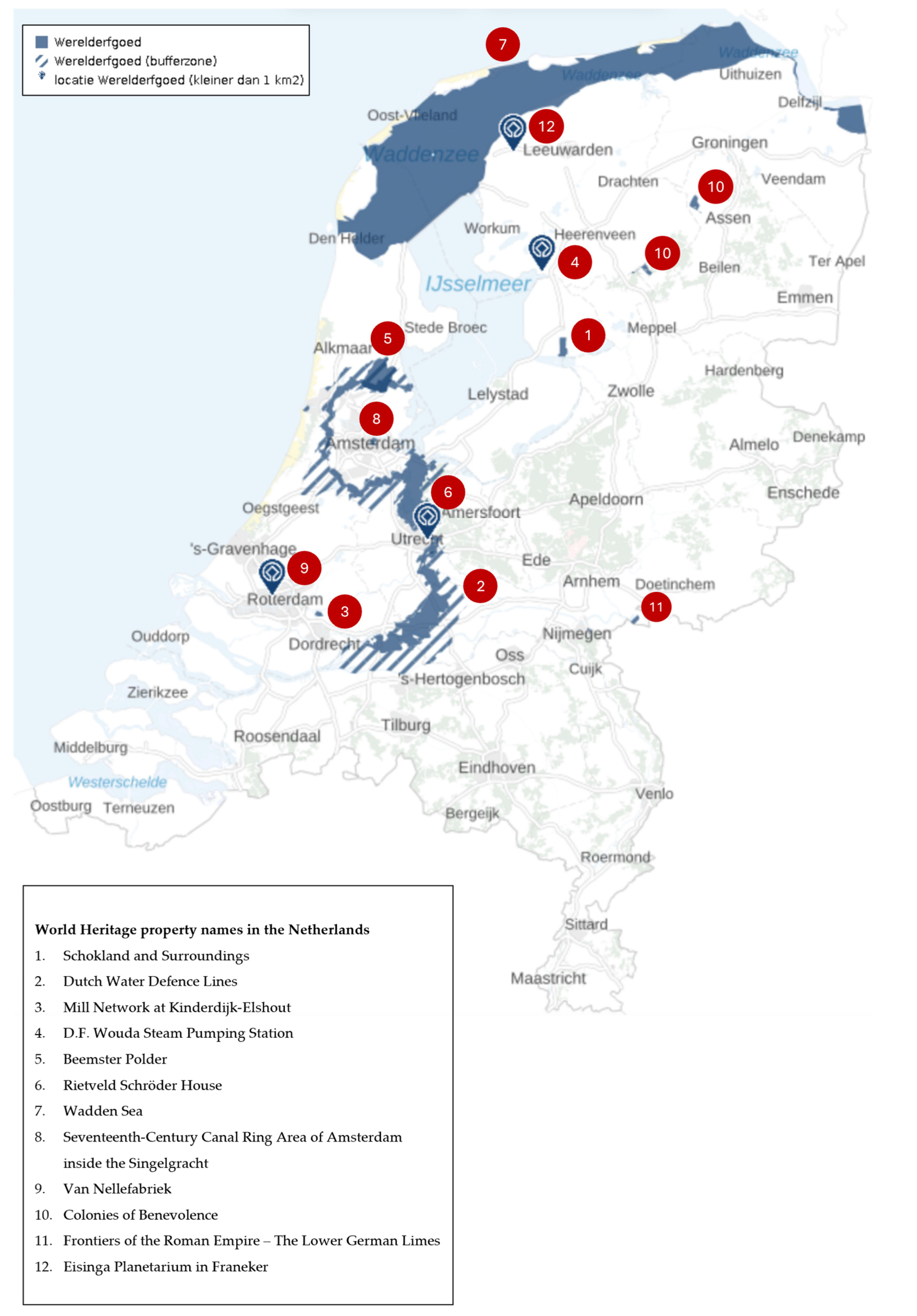
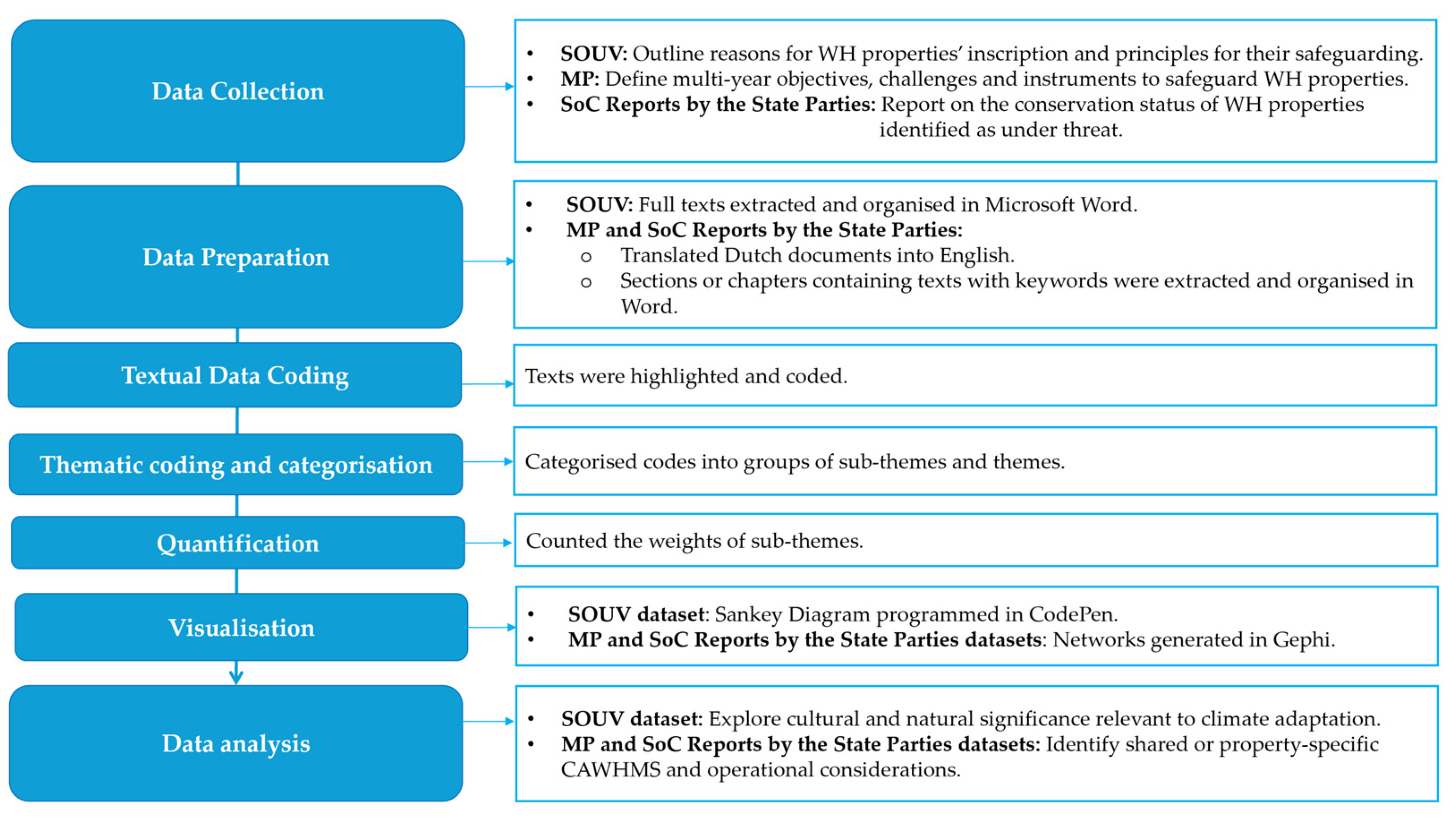
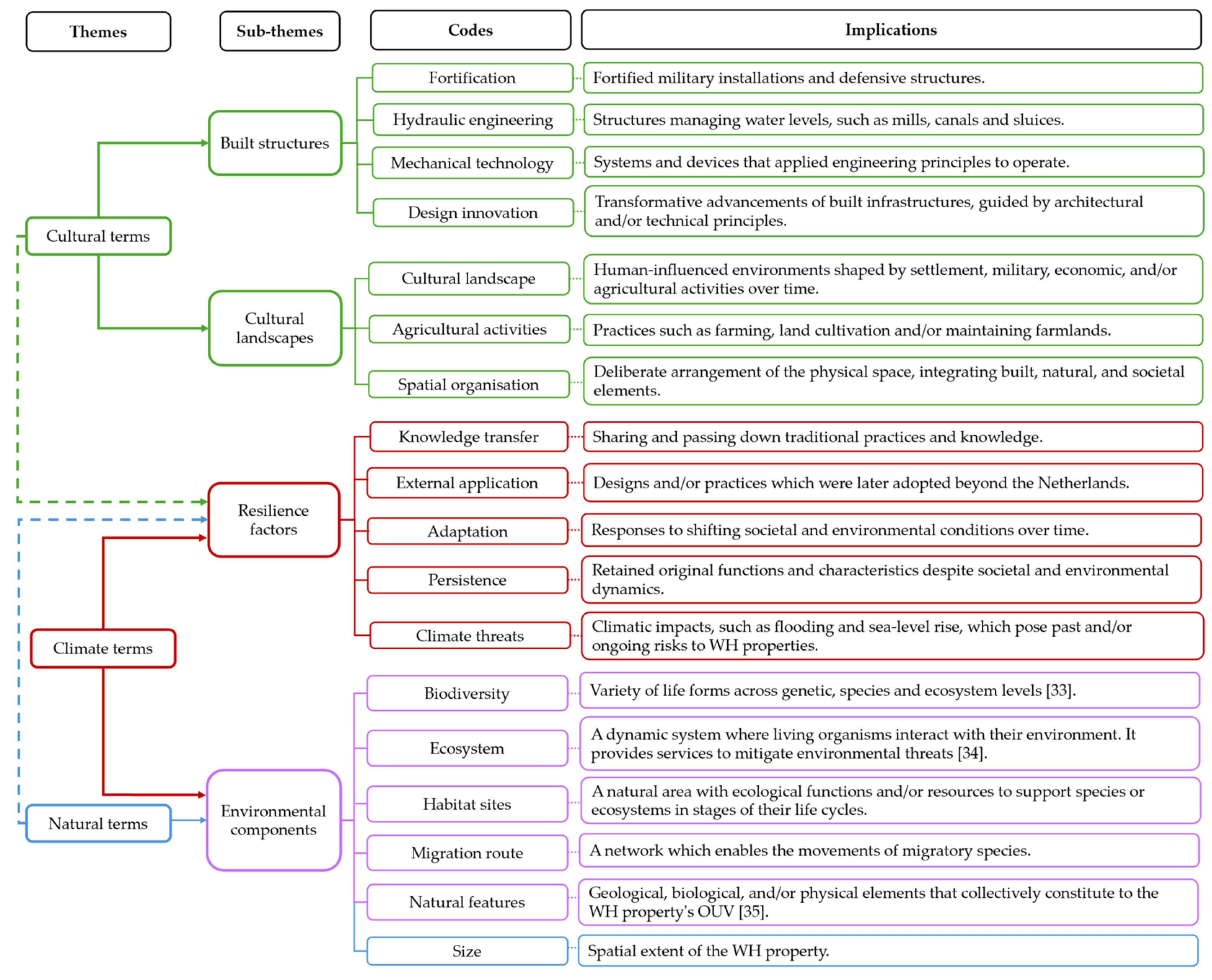
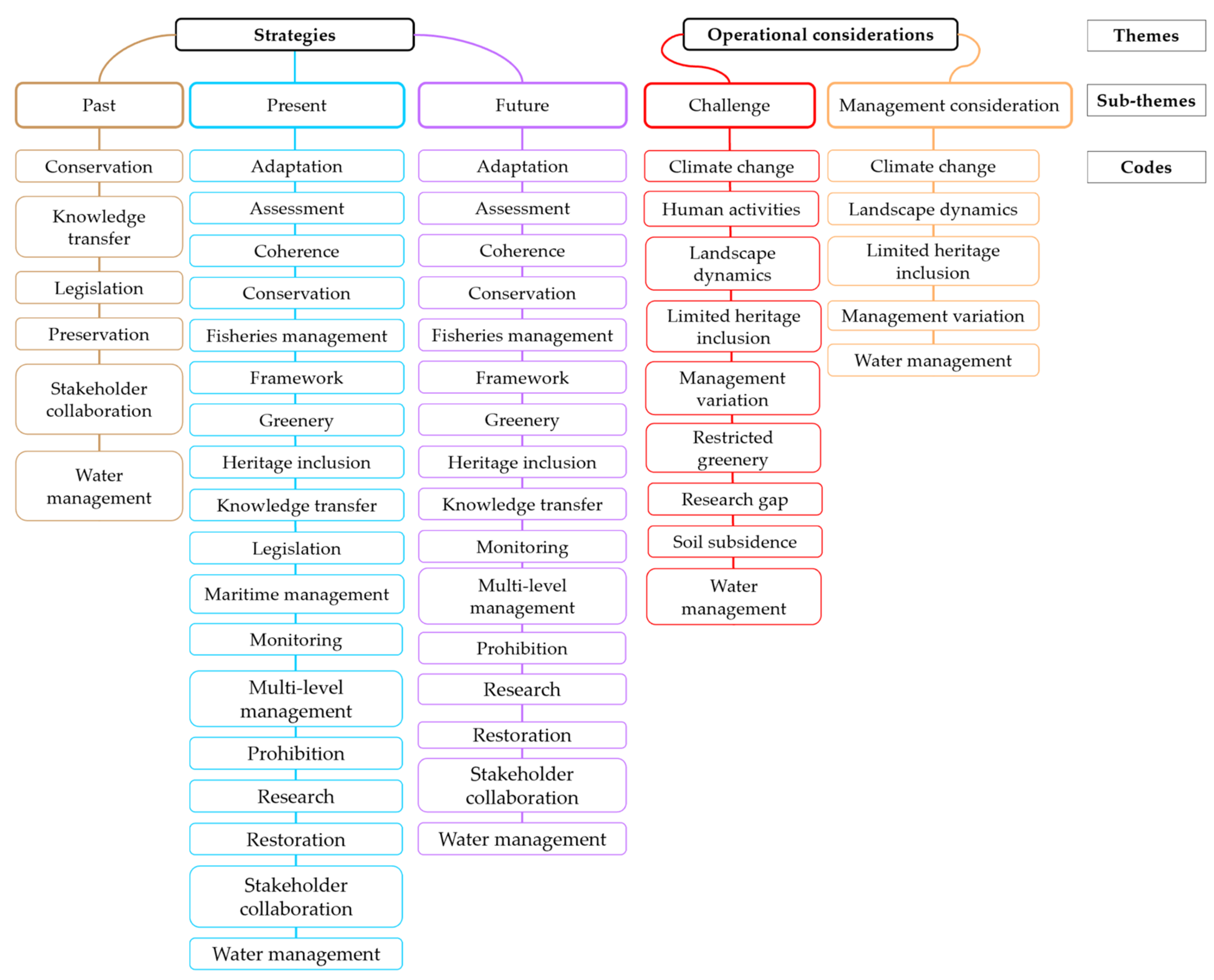
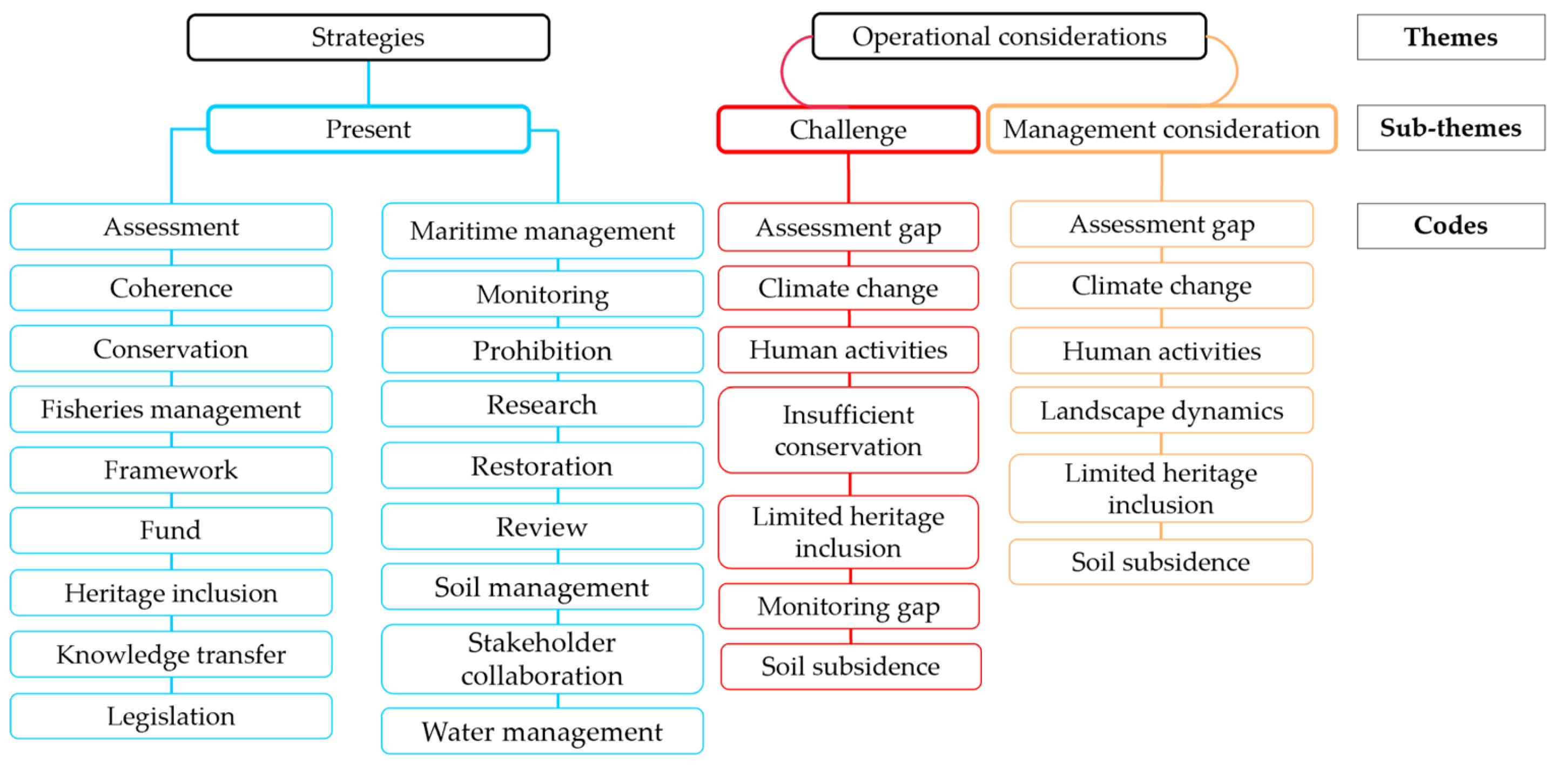
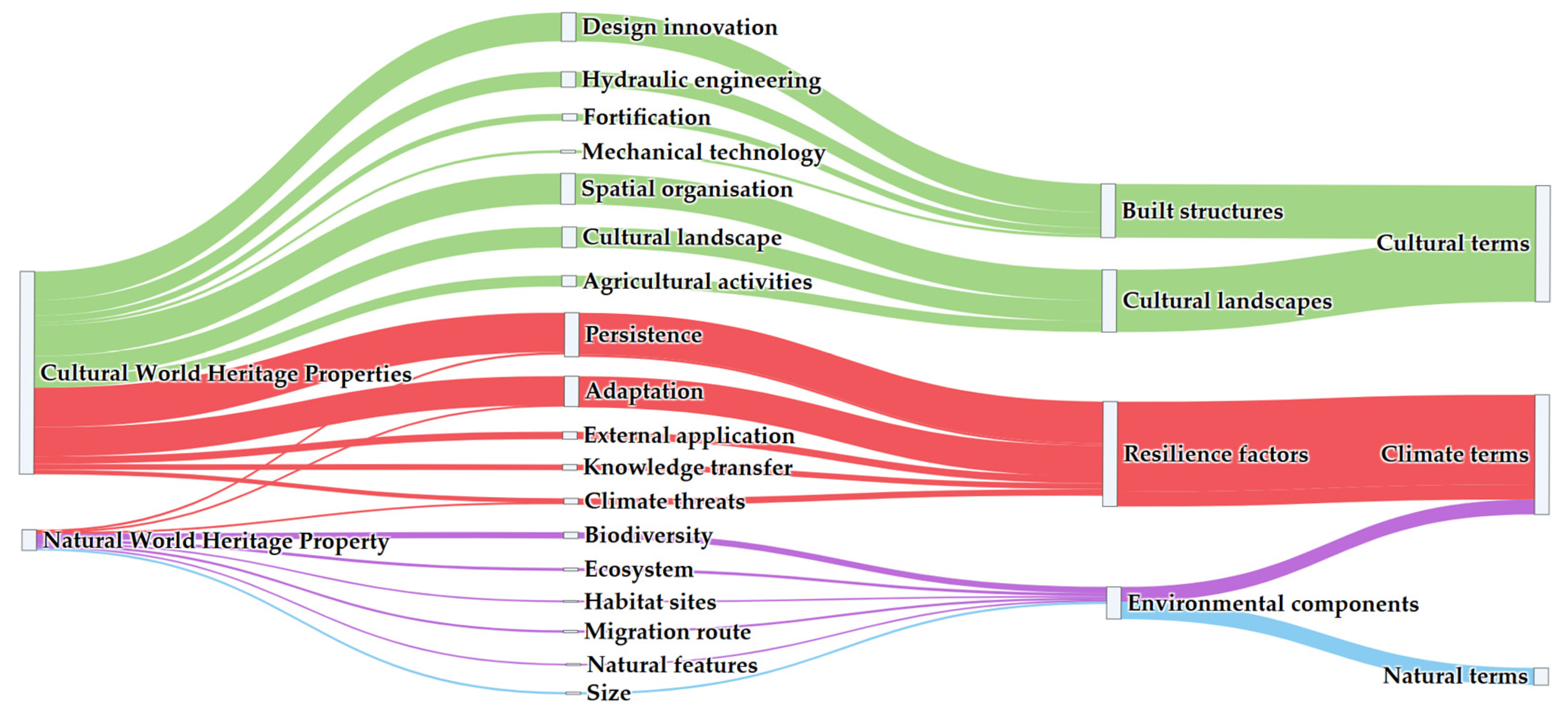
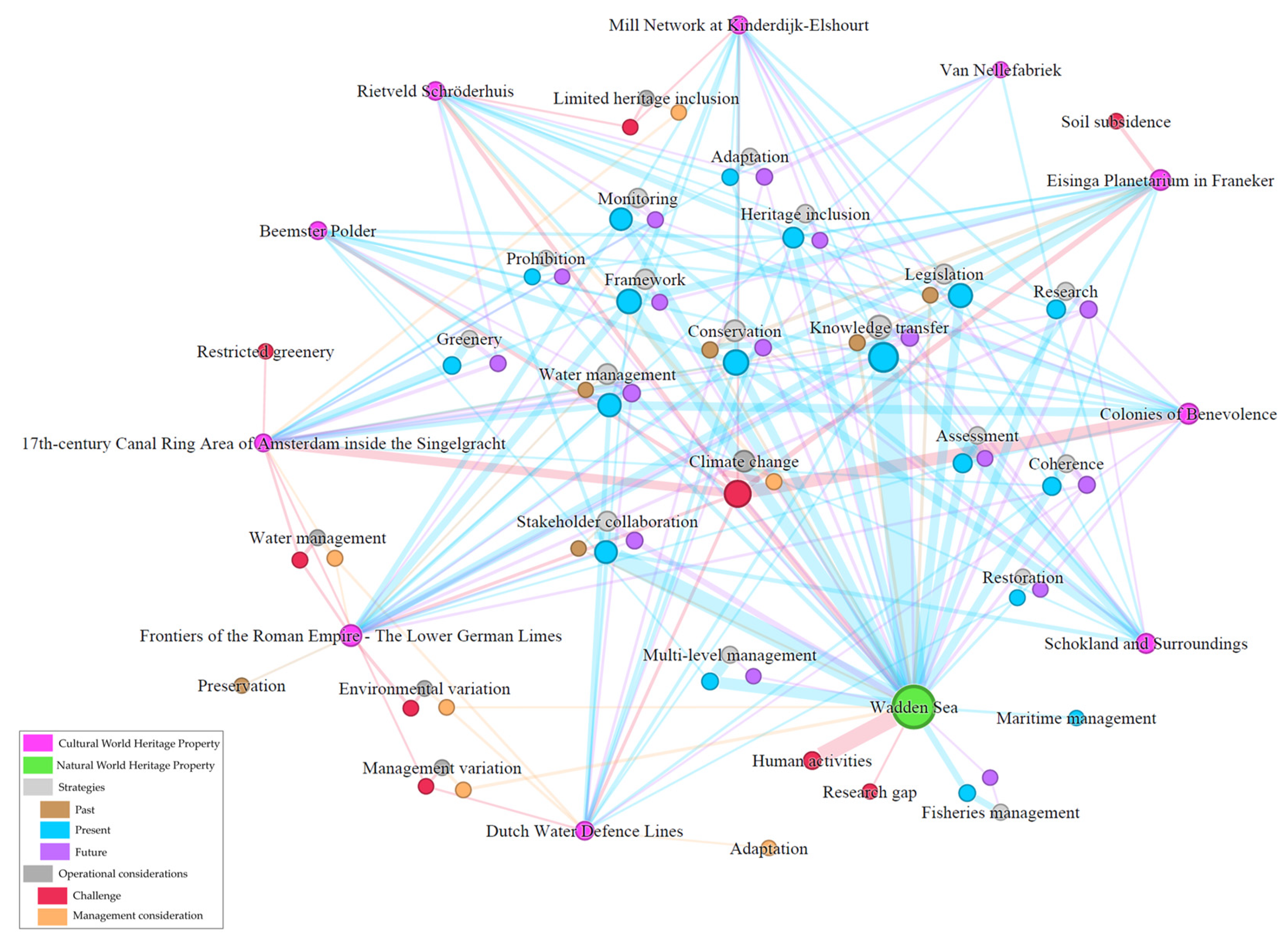
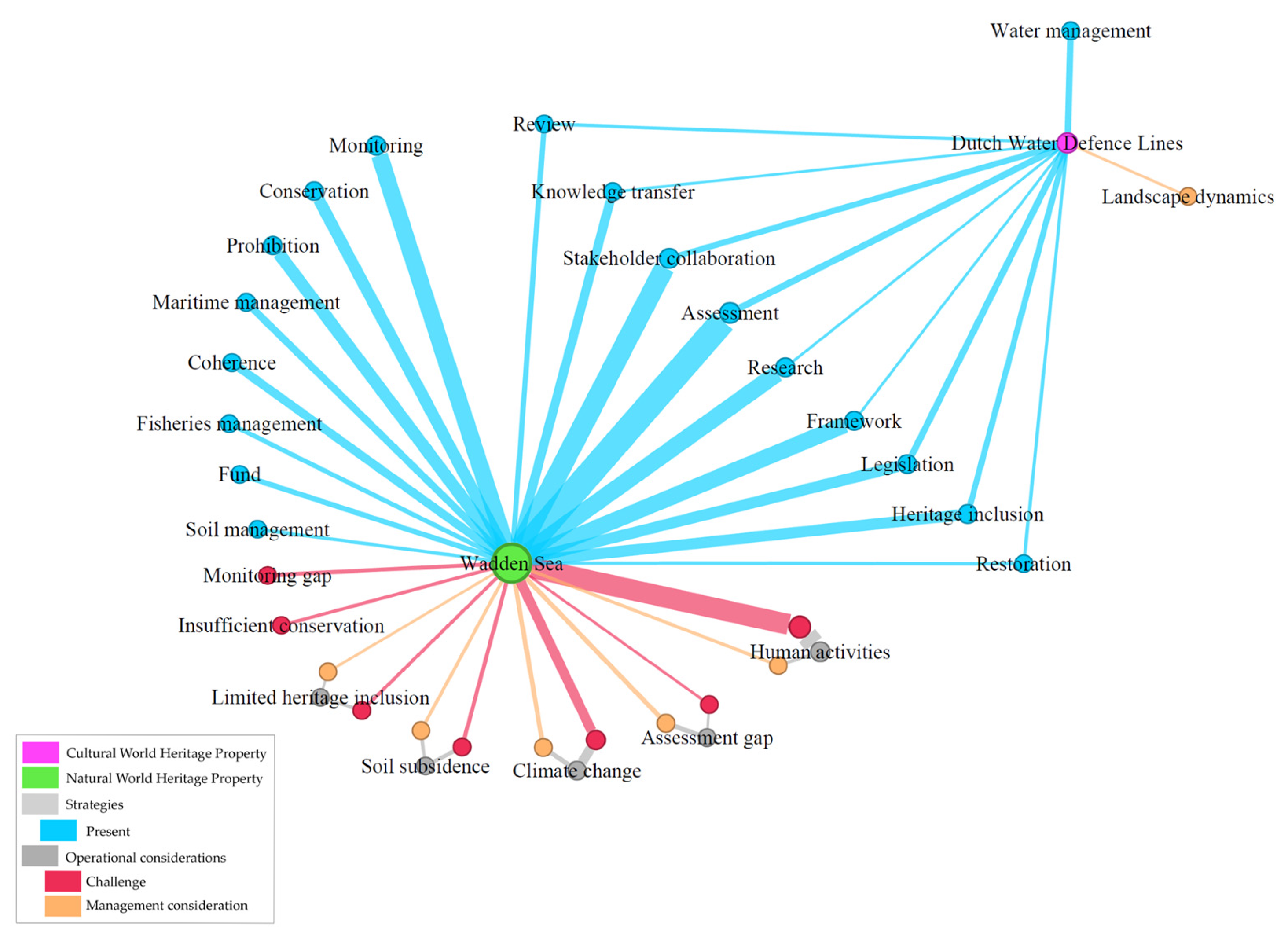
| Keyword | Implication | Source |
|---|---|---|
| Act; Decree; Legislation; Legislative | Legal provisions at provincial, national and international levels about climate change, environmental and spatial planning, nature protection, sustainable development and/or heritage protection. | [20] |
| Climate; Climate change | Climate and environmental changes may impose risks on the conservation status of WH properties. | [27] |
| Conservation | Efforts to safeguard WH properties from climate-driven and environmental threats. | [20] |
| Dry; Drought | A climate impact that leads to water scarcity. | [10] |
| Environment; Environmental | Environmental resilience affected due to climate impacts and/or human activities. For example, biodiversity loss is a result of rising temperatures. | [28] |
| Flood; Flooding; High water level | A climate impact that leads to water management challenges. | [10] |
| Framework | Provincial, national and transnational plans for climate adaptation and sustainable development. | [10] |
| Heat; Heat stress | A type of climate impact due to high temperatures. | [10] |
| Human activities | Anthropogenic factors that worsen climate impacts such as emitting greenhouse gas (GHG). | [29] |
| Research; Review; Assess; Monitor | Studies, assessments and monitoring efforts to identify climatic challenges and suggest measures for WH properties. | [29] |
| Restoration | To repair or recover damages caused by climate and environmental impacts on WH properties. | [14] |
| Sustainability; Sustainable development | Environmental sustainability and inclusive socio-economic development contribute to climate adaptation and building sustainable living environments. Within this context, texts may suggest integrating WH properties and their OUV into these efforts. | [14] |
| Code | Reference Text | WH Property |
|---|---|---|
| Spatial organisation | These include the pattern of waterways and roads with avenues of trees, a ring dyke and a ring canal, the historical structure and location of the villages, and the ribbon development of farms along the roads | Beemster Polder [5] |
| Spatial organisation | The network of canals in concentric arcs of a circle that forms the basis of the urban layout | 17th-century Canal Ring Area of Amsterdam within the Singelgracht [36] |
| Hydraulic engineering | …polders, high and low-lying drainage and transport channels for superfluous polder water, embankments and dikes, 19 drainage mills, 3 pumping stations, 2 discharge sluices | Mill Network at Kinderdijk-Elshout [37] |
| Hydraulic engineering | The Wouda Pumping Station represents the apogee of Dutch hydraulic engineering | D.F. Wouda Steam Pumping Station [38] |
| Code | Reference Text | WH Property |
|---|---|---|
| Biodiversity | Biodiversity on a worldwide scale is reliant on the Wadden Sea. | Wadden Sea [40] |
| Ecosystem | The Wadden Sea includes some of the last remaining natural large-scale intertidal ecosystems. | Wadden Sea [40] |
| Migration route | The property is the essential stopover that enables the functioning of the East Atlantic and African-Eurasian migratory flyways. | Wadden Sea [40] |
| Code | Reference Text | WH Property |
|---|---|---|
| External application | …provided the models and set the standards for the whole world for centuries | D.F. Wouda Steam Pumping Station [39] |
| Climate threats | The area provides exceptional evidence of a cultural tradition of island-dwellers threatened by the water and ultimately evacuated | Schokland and Surroundings [6] |
| Adaptation | …the innovative responses of Roman military engineers to the challenges posed by the dynamic landscape of a lowland river, as witnessed by the positioning and design of the military installations and by water management works. | Frontiers of the Roman Empire—The Lower German Limes [41] |
| Adaptation | …provide an invaluable record of the ongoing dynamic adaptation of coastal environments to global change | Wadden Sea [40] |
| Persistence | …survives in its entirety, with its old embankments and historic facade alignments | 17th-century Canal Ring Area of Amsterdam within the Singelgracht [37] |
| Code | Reference Text | WH Property |
|---|---|---|
| Knowledge transfer (Past strategy) | A milestone to collect and make this knowledge available started with the Wadden Sea network of engaged scientists in the 1960s. | Wadden Sea [42] (p. 33) |
| Knowledge transfer (Present strategy) | Stimulate and maintain trilateral knowledge exchange and interdisciplinary discussions about, among others best practices for adapting to climate change. | Wadden Sea [42] (p. 25) |
| Knowledge transfer (Future strategy) | Putting the Wadden Sea on the global scene also offers new pathways for international cooperation, mutual learning, and developing solutions for the preservation of the Wadden Sea in a rapidly changing world. | Wadden Sea [42] (p. 36) |
| Code | Reference Text | WH Property |
|---|---|---|
| Conservation (Present strategy) | For the canal ring area, proper maintenance and reinforcement of the tree structure along the canals and the ‘keur gardens’ behind the canal houses are part of the values to be protected. | 17th-century Canal Ring Area of Amsterdam within the Singelgracht [43] (p. 57) |
| Conservation (Present strategy) | This means that preventive measures will be taken in the water system and in spatial planning. Here, too, the world heritage and the maintenance of the existing ditch pattern are the starting point and precondition. | Beemster Polder [44] (p. 30) |
| Water management (Present strategy) | …rehabilitation of the Westerbeeksloot barge canal includes measures to improve the period of water retention in the barge canal, so as to increase resistance against dehydration for a longer period of time. | Colonies of Benevolence [45] (p. 189) |
| Water management (Future strategy) | With the right designs, this spatial planning challenge could contribute to making the Dutch Water Defence Lines easier to understand and recognise, by converting former inundation fields into areas for water retention. | Dutch Water Defence Lines [46] (p. 168) |
| Knowledge transfer (Present strategy) | At all primary schools in Noordoostpolder, the Schokland World Heritage site forms a permanent part of cultural education, so every child in primary education knows about Schokland. | Schokland and Surroundings [47] (p. 31) |
| Knowledge transfer (Present strategy) | The TWSC together with the Wadden Sea Forum, relevant authorities, environmental NGOs, and other partners, to facilitate trilateral dialogue regarding climate- and nature-friendly shipping in the trilateral Wadden Sea. | Wadden Sea [42] (p. 29) |
| Code | Reference Text | WH Property |
|---|---|---|
| Limited heritage inclusion (Challenge) | The provincial environmental vision does not specifically address the Rietveld Schröder House. | Rietveld Schröderhuis [48] (p. 11) |
| Limited heritage inclusion (Management consideration) | It is recommended that in future attention for heritage will be included as an eighth theme, or to explicitly include heritage in the living environment and materials themes. | 17th-century Canal Ring Area of Amsterdam inside the Singelgracht [43] (p. 57) |
| Heritage inclusion (Future strategy) | World Heritage can provide a platform for this by developing and testing new approaches that assess the relevance of heritage for establishing sustainable development. | Mill Network at Kinderdijk-Elshout [49] (p. 19) |
| Heritage inclusion (Present strategy) | …the Outstanding Universal Value is considered in the design phase of the dyke-strengthening, for example around the Honswijk-Everdingen fort complexes. | Dutch Water Defence Lines [46] (p. 168) |
| Research (Present strategy) | An initial study showed that this can reduce the gas consumption of the complex by approximately 80% and the power consumption of the data centre by approximately 30%. | Van Nellefabriek [50] (p. 14) |
| Heritage inclusion (Present strategy) | The latter article is especially imperative. It literally states that in the environmental plan the importance of the preservation of the Outstanding Universal Value of World Heritage should be taken into account. | Eisinga Planetarium in Franeker [51] (p. 73) |
| Code | Reference Text | WH Property |
|---|---|---|
| Restoration (Present strategy) | At Fort Vuren, the eastern inundation sluice will be restored and will become a functioning part of the water management system. | Dutch Water Defence Lines [52] (p. 11) |
| Restoration (Present strategy) | Lauwersmeer-Vierhuizergat, dyke improvement to restore the connection between the Wadden Sea and the hinterland, soften the hard edges of the mudflats, build gradual fresh-salt transitions, and develop salt marshes. | Wadden Sea [53] (p. 44) |
| Knowledge transfer (Present strategy) | …former battery of the Dalems sluice and the former dike warden’s hut ‘Hercules’ are now visible and their stories can be told. | Dutch Water Defence Lines [52] (p. 11) |
| Knowledge transfer (Present strategy) | In September 2022 a first Trilateral Youth Conference was organised. Young people already engaged in the Wadden Sea came together to exchange, discuss challenges, and collect ideas that were transferred to the trilateral ministers during the 14th Trilateral Governmental Conference in 2022. | Wadden Sea [53] (p. 41) |
| Assessment (Present strategy) | To define the core qualities in further detail, the site holder has commissioned sixteen area analyses to provide greater insight into where and how the core qualities emerge. This will facilitate sustainable conservation efforts and allow the core qualities to be used as a building block for development. | Dutch Water Defence Lines [52] (p. 2) |
| Research (Present strategy) | Explore and emphasise the potential of typical Wadden Sea habitats as “blue carbon” ecosystems to contribute to natural CO2 sequestration (e.g., saltmarshes, sediments). | Wadden Sea [53] (p. 10) |
Disclaimer/Publisher’s Note: The statements, opinions and data contained in all publications are solely those of the individual author(s) and contributor(s) and not of MDPI and/or the editor(s). MDPI and/or the editor(s) disclaim responsibility for any injury to people or property resulting from any ideas, methods, instructions or products referred to in the content. |
© 2025 by the authors. Licensee MDPI, Basel, Switzerland. This article is an open access article distributed under the terms and conditions of the Creative Commons Attribution (CC BY) license (https://creativecommons.org/licenses/by/4.0/).
Share and Cite
Cheang, K.; Bai, N.; Pereira Roders, A. Unveiling Climate-Adaptive World Heritage Management Strategies: The Netherlands as a Case Study. Sustainability 2025, 17, 5555. https://doi.org/10.3390/su17125555
Cheang K, Bai N, Pereira Roders A. Unveiling Climate-Adaptive World Heritage Management Strategies: The Netherlands as a Case Study. Sustainability. 2025; 17(12):5555. https://doi.org/10.3390/su17125555
Chicago/Turabian StyleCheang, Kai, Nan Bai, and Ana Pereira Roders. 2025. "Unveiling Climate-Adaptive World Heritage Management Strategies: The Netherlands as a Case Study" Sustainability 17, no. 12: 5555. https://doi.org/10.3390/su17125555
APA StyleCheang, K., Bai, N., & Pereira Roders, A. (2025). Unveiling Climate-Adaptive World Heritage Management Strategies: The Netherlands as a Case Study. Sustainability, 17(12), 5555. https://doi.org/10.3390/su17125555










